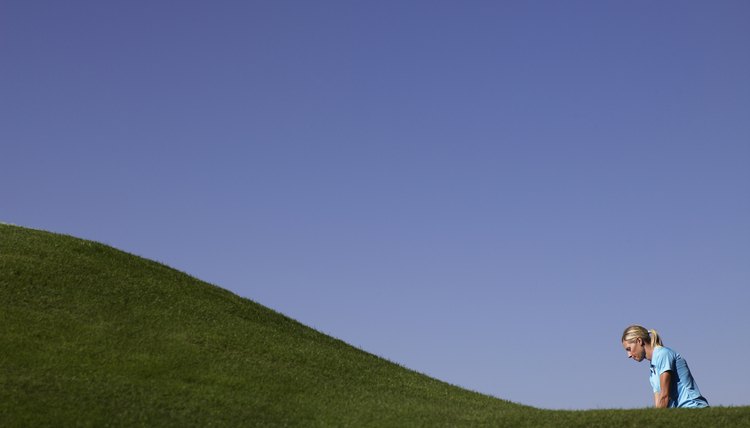How to Calculate Elevation Change in Golf

Golf is a demanding sport, with much more precision required than just brute strength and power. Playing golf at elevation is very difficult because the ball travels farther in the air in elevated climates like Colorado and Utah as opposed to normal elevation areas like the Midwest or East Coast. Also, you encounter uphill and downhill shots on the course, and golfers need to adjust on the fly.
On The Course
Pace off your yardage from the nearest sprinkler head to the center of the green. This baseline number is always a good starting point because the center of the green is never a bad spot.
Measure the distance to the flag using a rangefinder. Alternatives to this are to use a golf GPS, or to employ your yardage book and calculate the exact distance to the hole.
Subtract one club for every 15 feet of elevation change. For instance, if you have 160 yards down hill to the pin, and you would normally hit a 7-iron, the shot calls for an 8-iron because the ball will travel in the air longer than a shot to a flat green.
Add one club for every 15 feet of uphill elevation change. That same shot from 160 yards, but up hill, will play approximately one club longer because the ball will be on the ground much faster than a shot to a flat green.
Gauge the wind and adjust depending on your elevation. With downhill shots, the ball will be in the air longer, and therefore more susceptible to the effects of the wind. You should choose more club accordingly. On uphill shots, the wind will have slightly less effect.
Extreme Locales
Practice several shots when playing mountain courses in Colorado or Utah. According to "Golf Digest," the ball can fly up to 40 percent farther in the thin air of these environments. Every course is different, so experiment to find the ideal yardages.
Subtract one club for every 10 feet of downhill elevation change in these thin air climates. The air provides less resistance, and the ball will generally travel farther with every club in your bag.
Add one club for every 10 feet of uphill elevation change when playing in thin air. Although the ball will still travel farther, even going uphill, it will still get on the ground faster than a shot to a level green.
Tips
There is no substitute for practice of these shots. Many of these "feel" shots in golf are obtained through years of repetition and adjustments.
Warnings
Make sure you base your judgments off exact numbers to the center of the green and to the pin. Nothing throws off distance adjustments like obtaining the wrong yardages.
References
Writer Bio
Lyle Stefanavich started writing professionally in 2005. His work has appeared in the "Olivet College Echo," "Battle Creek Enquirer," "The South End Newspaper," TellUsDetroit.com, "Warrior Within Magazine," "Dearborn Press and Guide," Dethoops.com, CSTV.com, and UCSHO.com, among other publications. Lyle holds a Bachelor of Science in finance from Wayne State University and is pursuing his Master of Business Administration.
